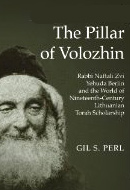A Pillar with a Past

The contemporary “yeshiva world,” in which young men spend almost all their waking hours for many years in the study of Talmud, traces its origins to Volozhin, a town a few miles west of Minsk in present-day Belarus, which in the 19th century was within the borders of Russia. Since the area’s Jews were culturally part of Jewish Lithuania, Volozhin and the other yeshivot that it spawned and inspired down to the present are deemed “Litvish,” a term that has come to connote not only geography but also such traits as erudition and keen rationality.
The Volozhin yeshiva was launched in 1803. While it did produce rabbis, it was not, strictly speaking, a rabbinical school. Rather than offering professional training, it was dedicated to the service of God through intense study of talmudic texts. The Russian government’s decision to close it in 1892 is commonly attributed to the school’s refusal to countenance secular studies in the curriculum, but the opening of tsarist Russia’s official archives after the fall of Soviet Communism has shown that the closure was due to internal disputes within the yeshiva and the regime’s fear of student radicalism.
The paramount personality in Volozhin’s history was Rabbi Naftali Zvi Yehuda Berlin (1816-93), often referred to as Netziv—which means “pillar” in Hebrew and is also the acronym of the first letters of his name. Rabbi Berlin’s life was virtually synonymous with the yeshiva. In 1830, at age 14, he went to Volozhin to marry a daughter of the head of the institution and to engage in full-time study. In 1853, after the deaths of his father-in-law and an older brother-in-law, he was placed in charge. He would run the yeshiva—not without several challenges to his authority—for nearly four decades, until it closed. In that role he was the mentor of many rabbinic leaders of the late 19th and early 20th centuries, including Rabbi Avraham Yitzhak Hacohen Kook, first Ashkenazi chief rabbi of Palestine. He also made an indelible impression on such yeshiva dropouts as the well-known Hebrew writer Micah Yosef Berdichevsky, who wrote essays about the yeshiva and its head, and the great poet Hayim Nahman Bialik, whose classic poem about yeshiva life, Hamatmid (“The Perpetual Student”), features Rabbi Berlin in a cameo role.
No serious biography of Netziv exists; but Gil S. Perl’s The Pillar of Volozhin, a revision of the author’s Harvard doctoral dissertation, not only sheds light on the rabbi’s intellectual development but also identifies a key historical watershed for the Litvish intellectual elite. Perl’s book compares two of Netziv’s important literary works. One is his well-known commentary on the Torah, Ha’amek Davar, written in the 1860s and 1870s, which has become a classic. The other work, far less famous, is Emek Hanetziv, a commentary on Sifre, the rabbinic midrash on the Books of Numbers and Deuteronomy that is believed to have been compiled in the third century C.E. Emek was not published in Netziv’s lifetime. Preserved in manuscript form by his descendants, it finally saw the light of day in 1958.
Midrash, as Perl explains, means “the way in which the rabbinic exposition is grounded in the words of the verse.” He finds convincing internal evidence that Netziv wrote Emek while still a young man, no later than the 1840s. Since Netziv’s coverage of Sifre’s midrash deals with the same biblical texts as his later commentary on Numbers and Deuteronomy in Ha’amek Davar, any difference in approach between the two works would be significant.
It is significant indeed. The earlier Emek demonstrates a “broad range of intellectual interests,” including grammar, semantics, ancient history, and popular science. It quotes not only traditional commentators but also Renaissance scholars whose religious Orthodoxy had been questioned, like Elijah Levita (recently discovered to be an ancestor of British Prime Minister David Cameron) and Azariah de Rossi. Even more striking, Emek cites Moses Mendelssohn, the very personification of 18th-century Jewish enlightenment, and his student Naftali Herz Wessely, whose proposal to reform Jewish education through the introduction of secular studies brought the wrath of the rabbinical establishment down on him.
Perl’s familiarity with early 19th-century Litvish culture enables him to place Emek within a broader context. It seems that Netziv was just one of many rabbinic scholars producing works on midrash; and these contemporaries, too, had no compunction about referring to secular disciplines and citing authorities outside the circle of tradition.
But in Netziv’s later Ha’amek Davar, published in 1879, the use of information from non-Torah sources is considerably curtailed; references to controversial non-rabbinic authorities are almost entirely gone, and a strong polemic stressing the centrality of Torah study and opposition to doctrinal deviation suffuses the work.
Perl suggests two reasons for the shift. One was personal: as head of the Volozhin yeshiva, Netziv now represented the rabbinic establishment and could not risk the intellectual chances he had taken as a little-known young man in a manuscript that he did not even publish. More significant, the times had changed. By the mid-1840s, the Russian Haskalah (Jewish enlightenment) had turned militant in its attacks on traditional Jewish life, even enlisting the government to set up alternative Jewish schools. The traditional society of Netziv’s youth, which had allowed for a certain intellectual openness, had been replaced by an either/or choice between what had become Jewish Orthodoxy, on the one hand, and secularization on the other. Netziv, of course, chose the former. By the end of the century, what Perl calls the yeshiva world’s “staunchly conservative and parochial stance” was well entrenched.
Much of the contemporary yeshiva leadership believes it is following Jewish tradition by focusing narrowly on talmudic learning to the exclusion of other fields of knowledge and diverse points of view. In this perceptive book, Gil Perl reveals just how recently this assumption emerged.
Lawrence Grossman, director of publications at the American Jewish Committee, edited the American Jewish Year Book from 2000 to 2008.
Comments are closed for this article.





http://blog.webyeshiva.org/podcast/volozhin-books